| |
|
|
|
|
|
|
|
|
|
|
| |
| |
 |
|
| |
田润德 编译文/图 2020-05-30
20:36 |
|
| |
|
|
|
|
| |
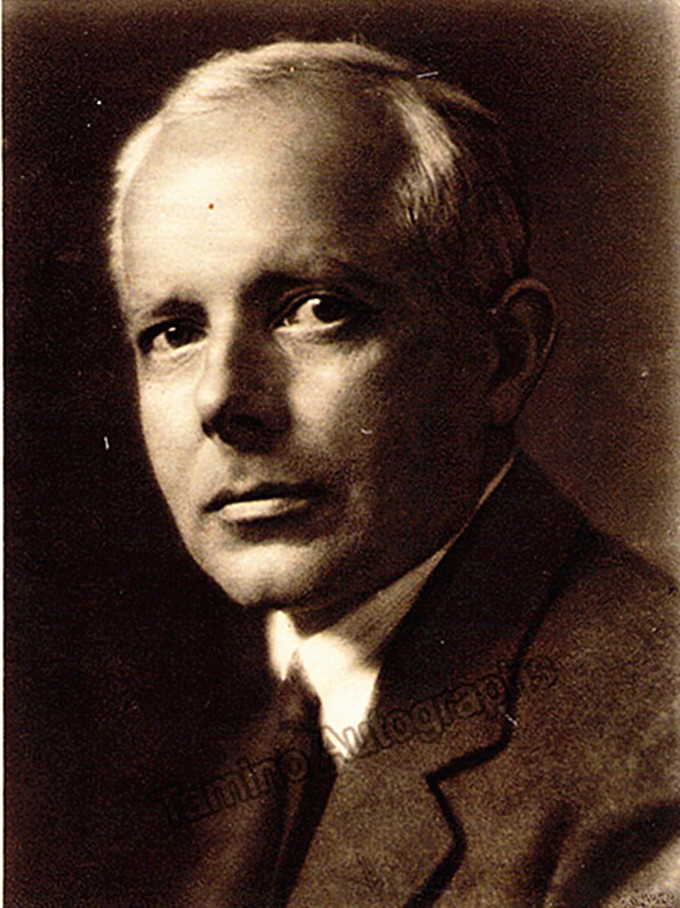 |
|
|
|
| |
贝拉·巴托克(Béla Bartók,1881-1945) |
|
|
|
| |
|
|
|
|
| |
莉莎·费尔施特曼演奏巴托克
《第一小提琴协奏曲》荷兰广播爱乐乐团
|
|
|
|
| |
Lisa
felstermann plays bartok's "violin concerto no. 1"
with the Dutch
radio philharmonic orchestra
|
|
|
|
| |
|
|
|
|
| |
音乐历史上的今天
1958年5月30日,巴托克的《第一小提琴协奏曲》首度在巴塞尔演出。50年前他把该作品献给小提琴家斯特菲·盖尔(Steffi
Geyer),而后者仅仅保存了乐谱却从未演奏过此曲。
当年斯特菲·盖尔(Steffi
Geyer)拒绝贝拉·巴托克的求婚时,这位作曲家陷入了深深的沮丧之中。由于无法入睡,他失去了食欲,沉迷于无法得到自己真正想要的东西。在接下来的许多年里,他的第一首小提琴协奏曲中的“斯特菲·盖尔”主题一直是他精神痛苦的标志。当他在情感上接近一个名叫玛塔·齐格勒的少女时,他的心情渐渐开朗起来。她的父亲是布达佩斯警察局的一名督察长,自1907年以来,她和姐姐赫尔马(Herma)一直在巴托克的私人学校里学习。玛尔塔后来回忆道:“贝拉总是在教书,他讲述自己的经历,想让自己的圈子更完善、更有学问。”当我们还是他的学生时,他就把佩斯博物馆和美术馆介绍给我和姐姐。他教我们星星的名字,如何准备他收集的昆虫和飞蛾,他向我们介绍了安迪尔迪和他喜爱的法国作家的诗歌:福楼拜,莫泊桑,道代特和他最喜爱的书之一雅各布森的尼尔斯莱恩。他还常常在晚上用钢琴为我演奏不知名的作品。他不是很忙,我只能猜作曲家是谁。”
1909年11月16日,巴托克带着16岁的玛尔塔散步。他们在他母亲家停了下来,她问玛尔塔是否要留下来吃晚饭。就在那时
巴托克向她透露他们刚刚结婚!他们的儿子小贝拉(Bela
Jr.)于1910年8月22日出生,玛尔塔深入参与了巴托克在广泛的野外考察中录制的民歌的转录和编辑过程。最终,他甚至带着年轻的妻子去阿尔及利亚和其他遥远的地方进行长期的研究旅行。他还完成并出版了几套钢琴作品,这些作品是在他与玛尔塔关系的早期阶段构思的。在献给玛尔塔的第一部滑稽剧《争吵》的草稿中,出现了一个有趣的条目。巴托克写道:“请选择其中一个标题:“因访问中断而愤怒”,或“浪子回头”,或“复仇是甜蜜的”,或“如果你能玩就玩”,或“11月27日”。巴托克和玛尔塔似乎是私人生活和职业生活的完美结合。
然而,像往常一样,也有让人分心的事情。1915年夏天,巴托克被介绍给克拉拉,一个首席林业工程师十几岁的女儿。克拉拉聪明、意志坚强,对诗歌和文学有着浓厚的兴趣。她的十首诗发表在当地的杂志上,巴托克深深地爱上了她。为了娶玛尔塔,他提出与她离婚,但克拉拉对嫁给一个比她大20岁的男人一点也不感兴趣。最终巴托克断绝了这段关系,这给他和他的婚姻带来了巨大的心理动荡。这次联络的直接成果是五首歌,作品15。在这五首歌中,有四首歌是克拉拉自己写的,歌名分别是《我的爱》(My
Love)、《欲望之夜》(Nights of desire)和《在生动的梦境中》(In Vivid
Dreams),表达了她在性方面的觉醒。巴托克很清楚这一潜在的丑闻,并声称是他自己写的这些文字。然而,没有人相信他,谣言开始传播。
尽管受了重伤,玛尔塔还是决定不去计较丈夫的轻率。她还同意丈夫和儿子在1916年7月25日皈依一神论。父亲和儿子加入了布达佩斯的一神派教会教会堂,巴托克短暂地担任了音乐委员会的主席。巴托克还把他的整个家庭都吸引到一种被称为“Freikorperkultur”的锻炼和社区生活方式中,大致翻译过来就是“自由身体文化”。它倡导裸体的自然主义公共体验,但与性没有直接关系。巴托克和他的家人会在他们的前花园全裸运动,导致与邻居的关系相当不好。玛尔塔后来回忆说:“巴托克每天早上都会裸体锻炼,尽可能早地晒太阳。他能很好地忍受太阳,在晒日光浴的时候,他会继续工作,学习语言,写作文。“甚至有报道称,在蓝胡子城堡的日光浴室里,巴托克每天只戴一副太阳镜,工作六到八个小时。”
玛尔塔愿意忽略很多东西,然而,在1923年,当巴托克再次爱上一个年轻的学钢琴的学生时,她并没有视而不见。他的新目标是19岁的伊迪丝·帕斯多里,在和妻子激烈的争论之后,巴托克把玛尔塔和他们的儿子贝拉一起送到了她的家乡特兰西瓦尼亚。玛尔塔似乎被告知不要再来了。显然这是玛尔塔的建议,他们在1923年6月没有争吵的情况下离婚了。离婚两个月后,巴托克与迪塔结婚,他们的儿子彼得于1924年出生。但这是我们下一集的主题。
今日视频:1、莉莎·费尔施特曼演奏巴托克《第一小提琴协奏曲》;2、
佐尔坦·什克利(Zoltan
Szckely)演奏——巴托克《第一小提琴协奏曲》 。
|
|
|
|
| |
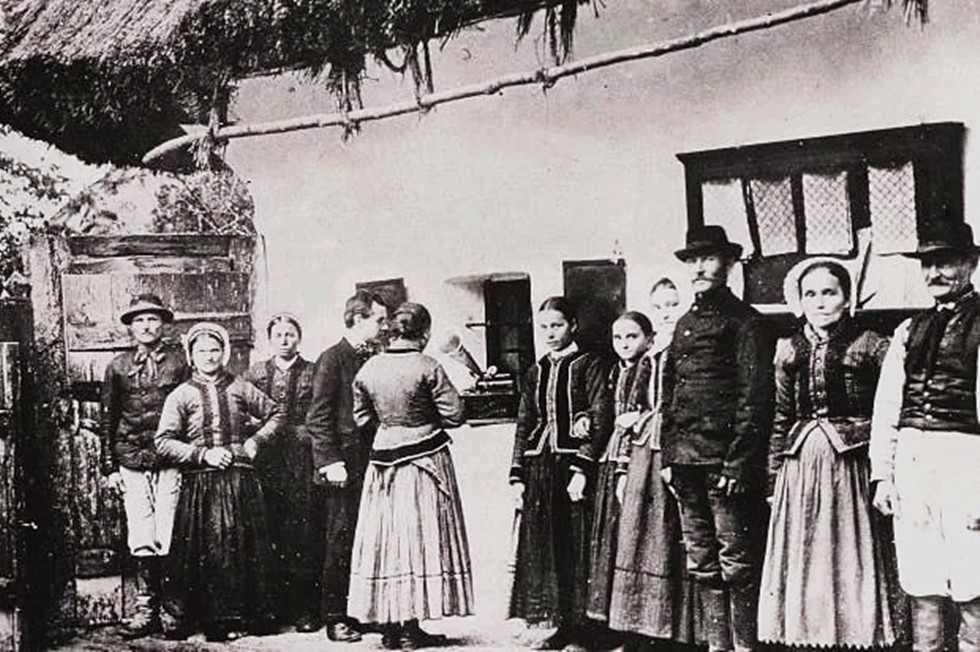 |
|
| |
巴托克和农民在一起(Béla Bartók)在特兰西瓦尼亚记录民歌 |
|
|
|
| |
下层阶级的人,越是坚持传统,就越好。但是,最高阶级的人必须努力使自己尽可能地摆脱它。没有中间道路。所以中产阶级,站在最高人民和农民阶级之间,由于它的愚蠢,实际上是不愉快的。我们喜欢农民的天真烂漫,这种天真烂漫表现在一切事物上,往往带有原始的力量;最高人民的智力力量令人印象深刻,但中产阶级的愚蠢——包括大多数“绅士”——缺乏天生的天真,令人难以忍受。
1907年7月27日,巴托克致小提琴家斯特菲·盖耶的一封信。音乐,
马尔科姆·吉利斯和艾德丽安·贡博兹,未出版
|
|
|
|
| |
With the
lowest class, the folk, it is all the nicer the more they stick
to tradition. But people of the highest class must strive to
free themselves from it, as far as possible. There is no middle
way. ... So the middle class, which stands between the highest
people and the peasant class, is, owing to its stupidity,
actually unenjoyable. We like the childlike naivety of the
peasants, which manifests itself in everything often with
primitive strength; the intellectual strength of the highest
people is impressive, but the idiocy of the middle
class—including most of the “gentry”—which lacks natural
naivety, is insufferable.
Bartók to violinist Stefi Geyer, July 27, 1907, in Bartók
Letters. The Musical Mind,
ed. Malcolm Gillies and Adrienne Gombocz, unpublished |
|
|
|
| |
我坚信并承认,每一种真正的艺术都是在我们从外部世界获得的印象——“经验”——的影响下产生的。我无法想象艺术作品,除了创作者表现他无限的热情、绝望、悲伤、愤怒、复仇、扭曲的讽刺、讽刺。我一直不相信这一点,直到我亲身体验到,一个人的作品实际上比传记更准确地展现了生活中值得注意的事件和强烈的激情。奇怪的是,迄今为止,在音乐中,只有热情、爱、悲伤,也许还有绝望——也就是所谓的崇高情感——作为动机。然而,只有在我们这个时代,复仇、夸张和讽刺才会或将会出现在音乐中。所以,也许,与早期明显的理想主义相反,当当代构图坦率而不加区别地表现出来的时候,我们就有可能称它为现实主义。 |
|
|
|
| |
I strongly
believe and profess that every true art arises under the
influence of impressions—“experiences”—which we gather from the
external world. ... I cannot visualize artistic productions in
any way other than the creator’s manifestation of his boundless
zeal, despair, grief, rage, vengeance, twisted irony, sarcasm. I
did not believe this until I experienced for myself that one’s
work actually shows more exactly than a biography the noteworthy
events and driving passions of a life. ... It is strange that
hitherto in music only zeal, love, grief and perhaps
despair—that is, the so-called sublime emotions—have acted as
motivations. While it is only in our time that vengeance,
hyperbole and sarcasm do or will live in music. So, perhaps, in
contrast to the idealism evident in earlier times it is possible
to call contemporary composition realistic when it candidly and
indiscriminately. |
|
|
|
| |
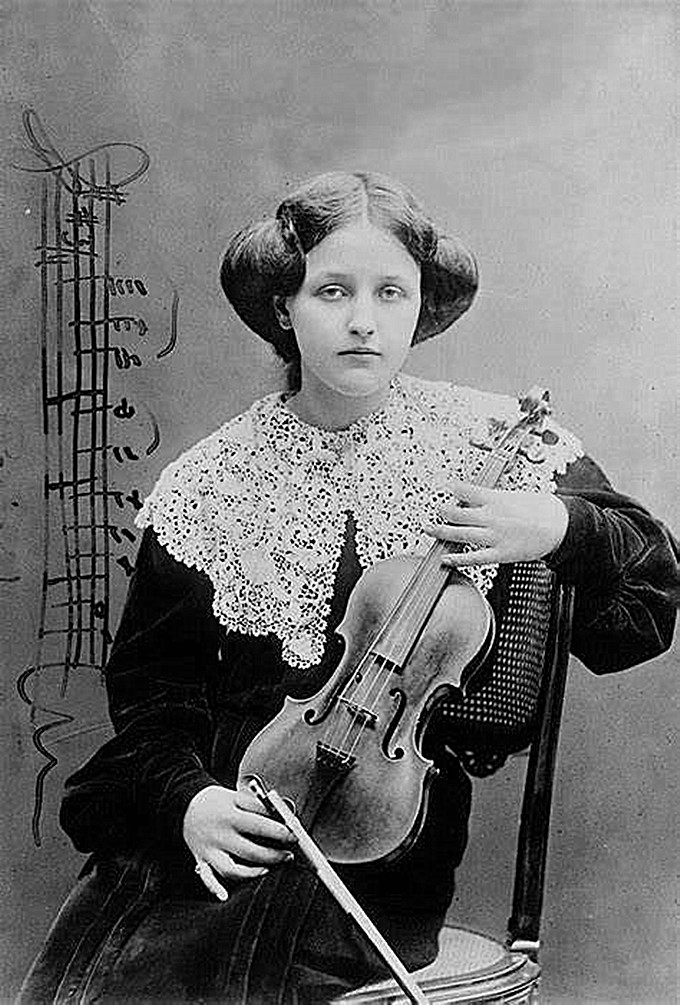 |
|
|
|
| |
巴托克心灵之诗所托之人——小提琴家斯特菲·盖尔(Steffi
Geyer),当年巴托克把优美的音诗题献给她,但她并未珍惜,也未演奏这首乐曲。 |
|
|
|
| |
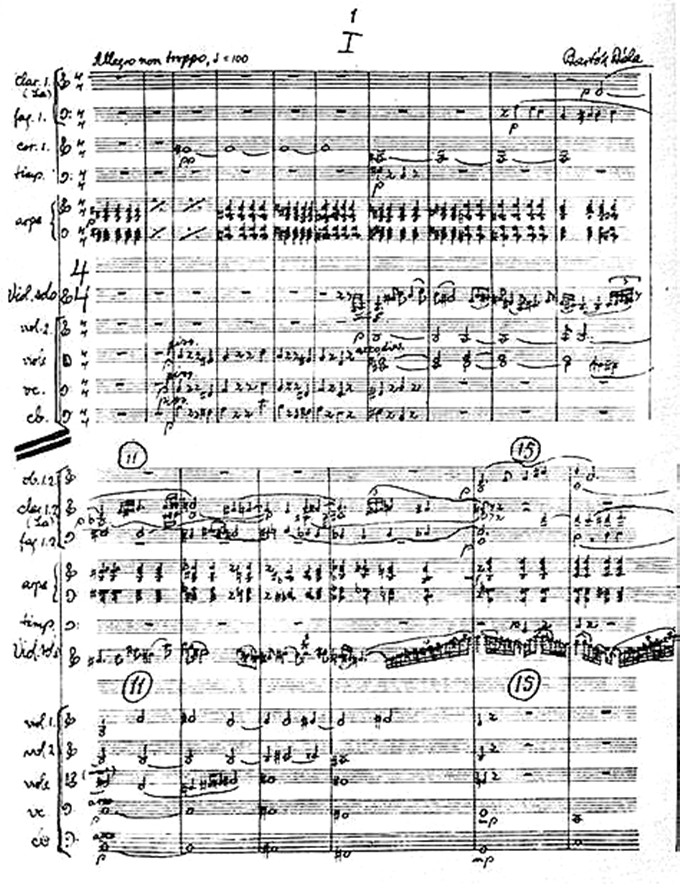 |
|
|
|
| |
巴托克第一小提琴协奏曲总谱的第一页(Paul
Hindemith) |
|
|
|
| |
1943年10月,巴托克第一次听到了自己的《小提琴协奏曲》的演出,‘那是在纽约,由托西·斯皮瓦科夫斯基演奏。巴托克听后写道:“精彩极了,独奏、指挥,乐队都是第一流的!(作者也是!)”下一个月,他第一次和耶胡迪·梅纽因相见,深深为梅纽因的演奏所感动。梅纽因在一次音乐会上演出了巴赫的《C大调奏鸣曲》和巴托克的《第一小提琴奏鸣曲》。巴托克写信给克里尔夫人说:“我的奏鸣曲……拉得精彩极了。如果演奏者是一位真正的大艺术家的话,就不需要作曲家给他帮助、给他出主意。他自己会得其神而传之。有这样一位青年艺术家对于并不叫座的现代音乐作品感兴趣,而且喜欢现代音乐,又拉得那样‘毫无缺点’,真是莫大的幸事!”(1943年12月17日)。
——《巴托克传》(拉约什·莱斯瑙伊) |
|
|
|
| |
In October
1943, bartok heard his first performance of "violin concerto,"
played by tosi spivakovsky in New York.When bartok heard this,
he wrote, "it was wonderful. The solos, the conductor, and the
orchestra were superb!(so does the author!)"The next month, he
met Yehudi Menuhin for the first time and was deeply moved by
menuhin's performance.Menuhin performed Bach's sonata in C major
and bartok's sonata for the first violin at a concert.Bartok
wrote to Mrs. Collier: "my sonata...It was a wonderful
performance.If the performer is a truly great artist, he does
not need the help and advice of the composer.He himself will
receive his god and pass it on.It is a great blessing to have a
young artist who is interested in modern music, which is not a
hit, and who enjoys it, and who plays it so
'flawlessly'!""(December 17, 1943).
——The life of bartok (rajesh lesnouy) |
|
|
|
| |
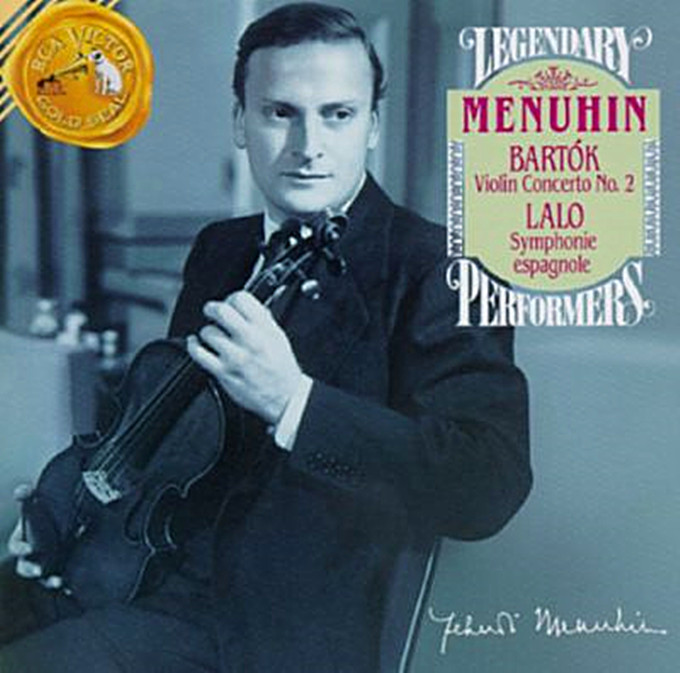 |
|
|
|
| |
耶胡迪·梅纽因演奏巴托克第一小提琴协奏曲的唱片封面 |
|
|
|
| |
Today in the
history of music
On May 30, 1958, bartok's violin concerto no. 1 was first performed in
Basel.He dedicated it 50 years ago to the violinist Steffi Geyer, who
kept the score but never played it.
When Stefi Geyer rejected Béla Bartók’s proposal of marriage, the
composer fell into a deep depression. Unable to sleep, he lost his
appetite and obsessed with not being able to attain something he truly
desired. And for many years to come, the “Stefi Geyer” theme from his
first violin concerto served as a musical signpost for his mental
anguish. His mood gradually brightened as he drew emotionally closer to
a teenage girl named Márta Ziegler. She was the daughter of an
inspector-general of the Budapest police, and together with her sister
Herma had been studying privately with Bartók since 1907. Márta later
recalled, “Béla was always teaching, he gave of his own experience and
wanted to make his circle more developed and learned. He acquainted my
older sister and me with the Pest museums and galleries while we were
still his pupils. He taught us the names of the stars, how to prepare
the insects and moths that he collected, he acquainted us with the
poetry of Endre Ady’s and his beloved French writers: Flaubert,
Maupassant, Daudet and one of his best-loved books Jacobsen’s Niels
Lyhne. He also used to play unknown works for me on the piano in the
evenings he was not too busy and I had to guess the composer.”
On 16 November 1909, Bartók took the sixteen-year-old Márta for a walk.
When they stopped at his mother’s house, she asked if Márta was staying
for dinner. It was then that
Bartók revealed to her that they had just gotten married! Their son Béla
Jr. was born on 22 August 1910, and Márta became deeply involved in the
process of transcribing and editing the folk songs Bartók recorded
during his extensive field trips. Eventually, he would even take his
young wife on long research trips to Algeria and other far flung places.
He also completed and published several sets of piano pieces that were
conceived during the early stages of his relationship with Márta. A
draft of the Burlesque No. 1, “Quarrel,” which is dedicated to Márta,
shows an amusing entry. Bartok writes, “Please choose one of the titles:
“Anger because of an interrupted visit,” or Rondoletto à capriccio,” or
“Vengeance is sweet,” or “Play it if you can” or “November 27.” Bartók
and Márta, so it seemed, were a perfect private and professional match.
Yet there were distractions, as there always are. In the summer of 1915
Bartók was introduced to Klára, the teenage daughter of a chief forestry
engineer. Klára was intelligent and strong-willed and had a keen
interest in poetry and literature. Ten of her poems were published in a
local journal, and Bartók fell deeply in love. He proposed divorcing
Márta in order to marry her, but Klára was not remotely interested in
marrying a man twenty years her senior. Eventually Bartók broke off the
relationship, which created enormous psychological turbulence for him
and his marriage. The direct outcome of this liaison was a set of Five
Songs Op. 15. Klára had written the words to four of the five songs,
with individual titles like “My Love,” “Nights of Desires,” and “In
Vivid Dreams” conveying her sexual awakening. Bartók was well aware of
the potential scandal and claimed to have written the texts himself. Yet
nobody believed him and rumors started to spread.
Although deeply wounded, Márta decided to overlook her husband’s
indiscretion. She also consented to her husband’s and her son’s
conversion to Unitarianism on 25 July 1916. Father and son joined the
Mission House Congregation of the Unitarian Church in Budapest, and
Bartók briefly chaired the music committee. Bartók also drew his entire
family into an exercise and community living approach termed
“Freikörperkultur,” which loosely translates as “Free Body Culture.” It
advocated a naturistic communal experience of being nude, but without a
direct relationship to sexuality. Bartók and his family would exercise
in their front garden completely naked, causing rather bad relations
with the neighbors. Márta later recalled, “Bartók would exercise naked
each morning and take the sun as early as possible. He could stand the
sun particularly well and while sunbathing he would go on working,
studying languages, scoring his compositions.” It was even reported that
Bartok worked six to eight hours a day on the score of Bluebeard’s
Castle in his solarium wearing only a pair of sunglasses.”
Márta was willing to overlook a great deal, however, she was not about
to turn a blind eye in 1923, when Bartók had once again fallen in love
with a young piano student. The new object of his attention was the
19-year-old Edith Pásztory, and after a heated exchange with his wife,
Bartók sent Márta to her home territory of Transylvania with their son
Béla. Márta, so it seems, was told not to return. Apparently it was
Márta’s suggestion that they should divorce, which they did without
acrimony in June 1923. Two months after the divorce, Bartók married
Ditta and their son Péter was born in 1924. But that’s the subject of
our next episode
Video of the day: 1. Lisa felsterman playing bartok's violin concerto
no. 1; 2.2. Zoltan Szckely -- bartok's violin concerto no. 1. |
|
|
|
| |
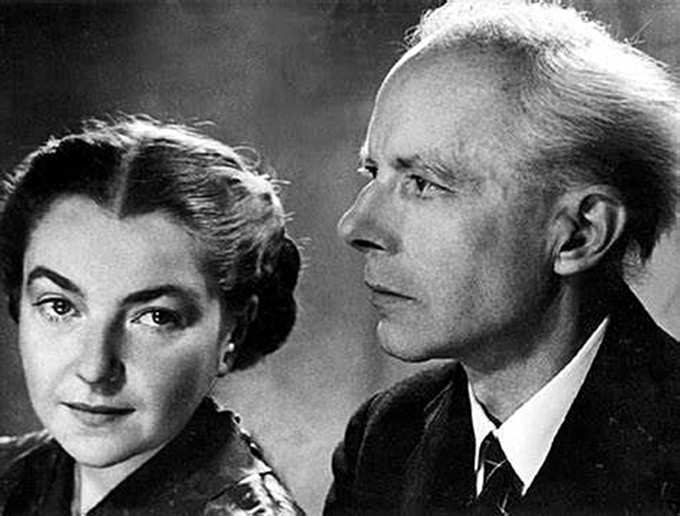 |
|
|
|
| |
贝拉·巴托克和第二任妻子玛尔塔·齐格勒(Marta
Ziegler) |
|
|
|
| |
玛尔塔·齐格勒(Marta
Ziegler)一篇未公开的日记 |
|
|
|
| |
贝拉·巴托克的一个特点是他总是在教书,他给出自己的经验,想让他的圈子更发达,更有学问。当我们还是他的学生时,他就把佩斯博物馆和美术馆介绍给我和姐姐。他教我们星星的名字,如何准备他收集的昆虫和飞蛾,他向我们介绍了安迪尔迪和他喜爱的法国作家的诗歌:福楼拜,莫泊桑,道代特和他最喜爱的书之一雅各布森的尼尔斯莱恩。
他过去常常在晚上不忙的时候用钢琴为我演奏不知名的作品,我只能猜测作曲家……当我问他收到关于我们儿子贝拉出生的电报后的第一个想法是什么时,他回答说(眼里含着泪水):“我的想法是玛尔塔·齐格勒(Marta
Ziegler),《十三年》(Thirteen Years),最初以《超级贝拉·巴托克》(Uber Bela
Bartok)的名字出版,多可文献展(Documenta Bartokiana 4, ed. Denijs Dille) |
|
|
|
| |
One of Béla
Bartók’s characteristic qualities was that he was always teaching, he
gave of his own experience and wanted to make his circle more developed
and learned. He acquainted my older sister and me with the Pest museums
and galleries while we were still his pupils. He taught us the names of
the stars, how to prepare the insects and moths that he collected, he
acquainted us with the poetry of Endre Ady’s and his beloved French
writers: Flaubert, Maupassant, Daudet and one of his best-loved books
Jacobsen’s Niels Lyhne.
He used to play unknown works for me on the piano on the evenings he
was not too busy and I had to guess the composer ... When I asked what
his first thought was on receiving the telegram about the birth of our
son Béla, he replied (with tears in his eyes): “My thought was that I
would teach him to write.”
Márta Ziegler, “Thirteen Years,” originally published as “Über Béla
Bartók,” in Documenta Bartókiana 4, ed. Denijs Dille
(Budapest, 1970), 173–7 |
|
|
|
| |
|
|
|
|
| |
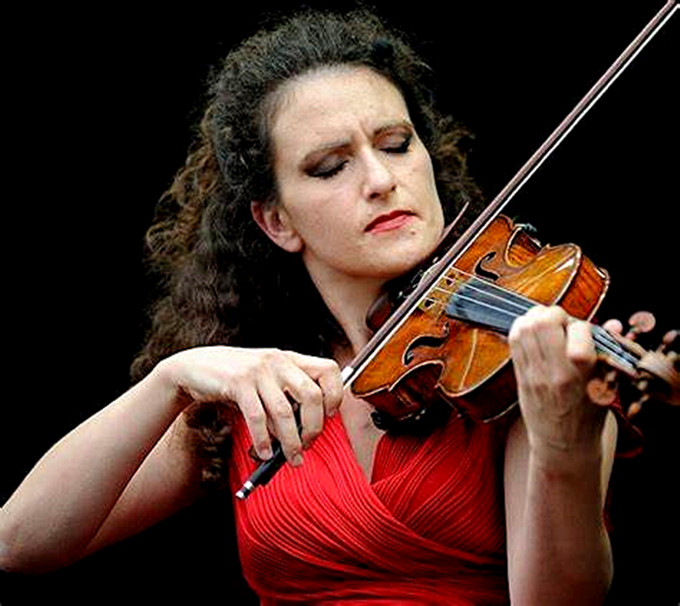 |
|
| |
莉莎·费尔施特曼(lisa felstmann)在演奏 |
|
|
|
| |
荷兰小提琴家莉莎·费尔施特曼与以热情的演奏风格和积极的台风而闻名。莉莎·费尔施特曼与生于俄罗斯的一个音乐世家,从小便受音乐的熏陶,可谓耳濡目染。最先对其产生影响的是小提琴家莉莎·费尔施特曼与(Philipp
Hirschhorn)。在此之后,她分别师从于阿姆斯特丹音乐学院的赫尔曼·克雷伯斯、费城柯蒂斯学院的艾达·卡瓦菲恩和伦敦的大卫·泰克诺,从他们那里接受到了正规的钢琴教育。2006年,她获得了荷兰的音乐家所能获得的最高荣誉——荷兰音乐奖(Dutch
Music Award)。
她也曾在纽约爱丽丝·图利音乐厅、伦敦维格莫尔大厅、维也纳金色大厅、阿姆斯特丹皇家大会堂进行演出,还出席过一些主要的国际室内乐音乐节。此外,莉莎·费尔施特曼与自2007年起担任代尔夫特室内音乐节的艺术总监,这是荷兰最受欢迎的音乐节之一。
莉莎·费尔施特曼与各个乐团都有过合作,其中包括BBC威尔士国家交响乐团、伦敦爱乐乐团、达拉斯交响乐团、旧金山交响乐团、埃森爱乐乐团、魏玛国家管弦乐团和石勒苏益格
-
荷尔斯坦节日乐团、比利时国家交响乐团、佛兰德斯交响乐团、布拉格广播交响乐团、马尔默交响乐团、卑尔根爱乐乐团、读卖日本乐团、马来西亚爱乐乐团、香港爱乐乐团以及几乎全部的荷兰乐团,包括阿姆斯特丹皇家大会堂管弦乐团和鹿特丹爱乐乐团。她曾合作过的指挥家包括
Stefan Blunier, Frans Brüggen, Christoph von Dohnányi, Claus Peter Flor,
Neeme Järvi, Yakov Kreizberg, Zdeněk Macál, Jun Märkl, Gianandrea
Noseda, Marc Soustrot, Leonard Slatkin, Thomas Søndergård, Karl-Heinz
Steffens, Mario Venzago, Jan Willem de Vriend 和Jaap van Zweden。
|
|
|
|
| |
 |
|
| |
莉莎·费尔施特曼(lisa felstmann) |
|
|
|
| |
Dutch violinist
lisa felstmann is known for her passionate playing style and aggressive
style.Lisa felsterman was born in Russia to a musical family. She was
influenced by music when she was a child.It was first influenced by the
violinists, lisa and Philipp Hirschhorn.After that, she received a
formal piano education from hermann klebber of the conservatory of music
in Amsterdam, Ada cavafian of the Curtis institute in Philadelphia, and
David tekno of London.In 2006, she won the Dutch Music Award, the
highest honor a Dutch musician can receive.
She has also performed at the Alice tully concert hall in New York,
wigmore hall in London, the golden hall in Vienna, the royal hall in
Amsterdam, and at some of the major international chamber music
festivals.In addition, lisa felstmann has been artistic director of the
delft indoor music festival, one of the most popular in the Netherlands,
since 2007.
Lisa fairfax shi terman co-operated with the every orchestra, including
the BBC national orchestra of wales, Dallas, London philharmonic
orchestra, the San Francisco symphony orchestra, Essen philharmonic,
weimar national orchestra and schleswig-holstein, Stan festival
orchestra, national symphony orchestra, Flanders Belgium radio symphony
orchestra, Prague symphony orchestra, malmo symphony orchestra, bergen
philharmonic orchestra, the yomiuri Japanese band, the Malaysian
philharmonic, the Hong Kong philharmonic orchestra, and almost all of
the Dutch bands, including the royal hall of Amsterdam and Rotterdam
philharmonic orchestra orchestra.She has worked with the conductor
including Stefan Blunier and Frans Bruggen, Christoph von Dohnanyi,
Peter Flor, Claus Neeme Jarvi and Yakov Kreizberg, Zden ě k Macal, Jun
Markl, Gianandrea Noseda, Marc Soustrot, Leonard Slatkin,Thomas S
ndergard, karl-heinz Steffens, Mario Venzago, Jan Willem DE Vriend and
Jaap van Zweden. |
|
|
|
| |
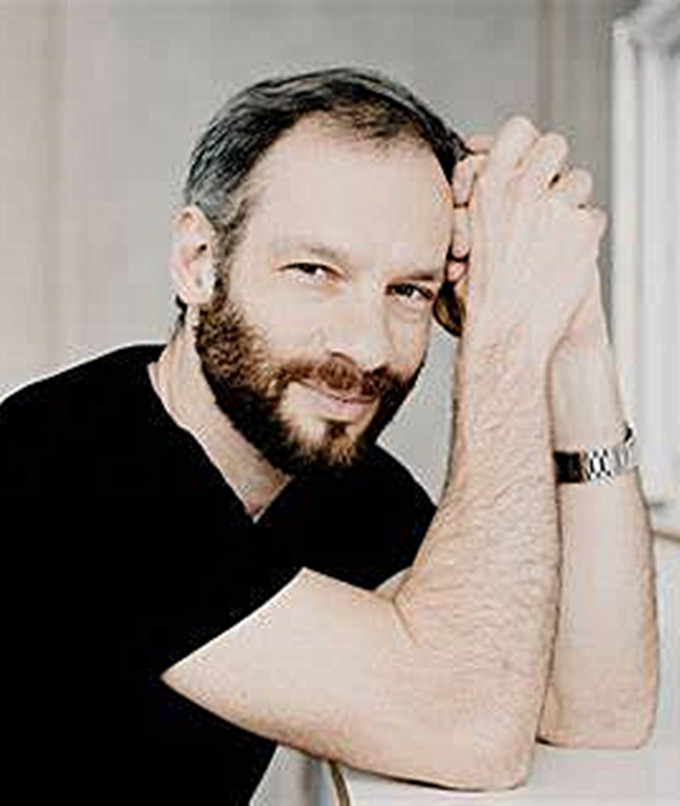 |
|
|
|
| |
迪马·斯洛波德尼乌克 (Dima Slobodeniouk ) |
|
|
|
| |
迪马·斯洛波德尼乌克 Dima Slobodeniouk
称赞他深深了解和智能艺术领导下,迪马·斯洛波德尼乌克
一直从事的音乐指挥的位置Sinfonica德加利西亚自2013年以来,结合他最近的职位是校长拉赫蒂交响乐团的指挥家和艺术总监的西贝流士节日后在2016年他的任命。他把自己的俄罗斯血统和他后来的祖国芬兰的文化影响联系起来,利用了这两个国家强大的音乐遗产。
上个赛季,他参加了自己的首场音乐会,包括哥本哈根、哥德堡和塔林之旅。他与柏林爱乐乐团等管弦乐队,Gewandhausorchester莱比锡Symphonieorchester
des Bayerischen Rundfunks,无线电Sinfonieorchester柏林,ORF
Radio-Symphonieorchester维恩,伦敦爱乐乐团、伦敦交响乐团、芬兰广播交响乐团、鹿特丹爱乐乐团、芝加哥、休斯顿和巴尔的摩以及悉尼交响乐团。
2019年夏天,斯洛波丹尼乌克将与波士顿交响乐团和耶菲姆·布朗夫曼(Yefim
Bronfman)一起重返坦格伍德音乐节,之后他将于今年10月在波士顿举行的该乐团主要系列演出中首次亮相。他在NHK交响乐团、首尔爱乐乐团、Tonhalle
Orchester Zurich和Simon Trpceski、维也纳交响乐团、旧金山交响乐团和Sergey
Khachatrian以及克利夫兰交响乐团首次登台演出。他回到伦敦爱乐乐团,荷兰广播爱乐乐团和休斯顿交响乐团。他以斯特拉文斯基的《圣咏交响曲》作为加利西亚的Orquesta
Sinfonica de Galicia 's 19/20
season的开篇;在巡回演出中,曾与伊莎贝尔·福斯特(Isabelle Faust)独奏的马德里民族中心音乐剧院(Centro
Nacional de Difusion Musical
Madrid)演出。与拉赫蒂交响乐团一起,他兴奋地与卡里塔·马提拉等独奏者一起庆祝西贝柳斯音乐节20周年。其他独奏者,他与包括尼古拉•Altstaedt列夫林里Andsnes,
Khatia Buniatishvili, Vilde Frang,瓦迪姆Gluzman,约翰尼斯•莫泽Baiba
Skride,西蒙•Trpčeski Yuja小王和弗兰克彼得·齐默尔曼。 |
|
|
|
| |
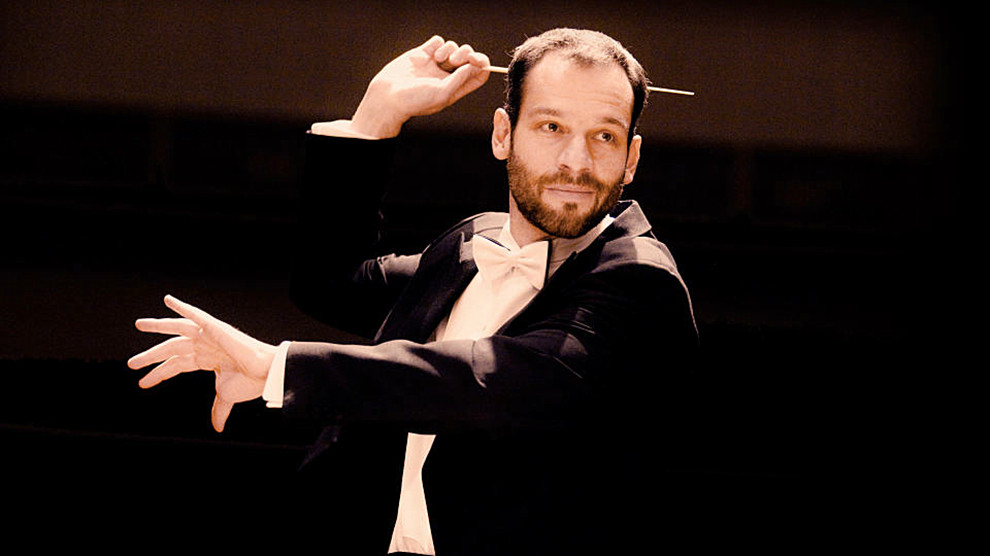 |
|
| |
迪马·斯洛波德尼乌克 (Dima Slobodeniouk ) |
|
|
|
| |
Lauded for
his deeply informed and intelligent artistic leadership, Dima
Slobodeniouk has held the position of Music Director of the Orquesta
Sinfónica de Galicia since 2013, which he combines with his more recent
positions as Principal Conductor of the Lahti Symphony Orchestra and
Artistic Director of the Sibelius Festival following his appointment in
2016. Linking his native Russian roots with the cultural influence of
his later homeland Finland, he draws on the powerful musical heritage of
these two countries.
Last season he gave his debut with the Het Concertgebouw Orkest,
including a tour to Copenhagen, Gothenburg and Tallinn. He works with
orchestras such as the Berliner Philharmoniker, Gewandhausorchester
Leipzig, Symphonieorchester des Bayerischen Rundfunks, Radio
Sinfonieorchester Berlin, ORF Radio-Symphonieorchester Wien, London
Philharmonic, London Symphony Orchestra, Finnish Radio Symphony,
Rotterdam Philharmonic, Chicago, Houston and Baltimore as well as Sydney
Symphony Orchestras.
Summer 2019 sees Slobodeniouk return to the Tanglewood Music Festival,
with the Boston Symphony Orchestra and Yefim Bronfman, before he gives
his debut in the orchestra’s main series in Boston in October this year.
Further highlights are his debuts with the NHK Symphony Orchestra, Seoul
Philharmonic Orchestra, Tonhalle Orchester Zürich with Simon Trpceski,
with the Vienna Symphony, with the San Francisco Symphony with Sergey
Khachatrian and with the Cleveland Orchestra. He returns to the London
Philharmonic Orchestra, Netherlands Radio Philharmonic Orchestra and
Houston Symphony with Kirill Gernstein. He opens the Orquesta Sinfónica
de Galicia’s 19/20 season with the Symphony of Psalms by Stravinsky; on
tour together, appearances include the Centro Nacional de Difusión
Musical Madrid with Isabelle Faust as soloist. With Lahti Symphony he is
excited to celebrate the 20th anniversary of the Sibelius Festival with
soloists such as Karita Mattila. Other soloists he works with include
Nicolas Altstaedt, Leif Ove Andsnes, Khatia Buniatishvili, Vilde Frang,
Vadim Gluzman, Johannes Moser, Baiba Skride, Simon Trpčeski, Yuja Wang
and Frank Peter Zimmermann. |
|
|
|
| |
|
|
|
|
| |
佐尔坦·什克利(Zoltan
Szckely)演奏——巴托克《
第一小提琴协奏曲》 |
|
|
|
| |
| |
Zoltan Szckely -- bartok's violin concerto no. 1 |
|
|
|
|
|
| |
|
|
|
|
| |
未得原作者编者授权严禁转载www.mt77.com任何内容 |
|
|
|
|
|
|
|
|
|
|
|
|
|
|


